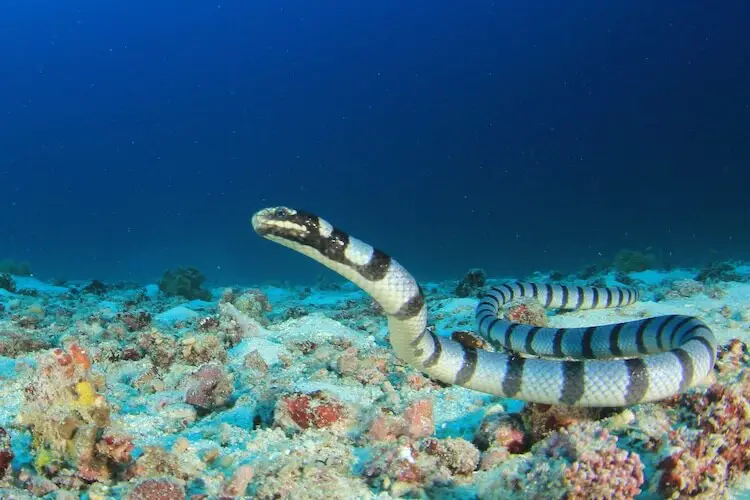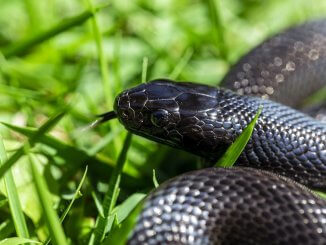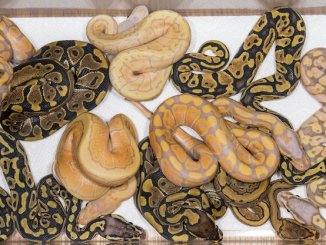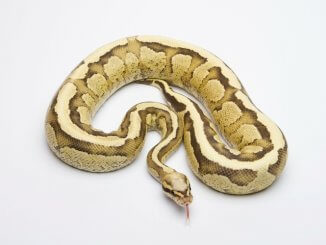Snakes are unique and interesting animals.
There are over 3,000 different species of snakes. Snakes live on every continent apart from Antarctica, in oceans and on mountains.
Snakes come in all types of shape, color and size. The largest ever snake recorded was a reticulated python at over 33 feet in length!
They are becoming a very popular pet and now over 500,000 households own a pet snake in the United States.
From why snakes hiss and how they move, to the world’s most venomous and largest species this article shares 23 of the most interesting facts about snakes…

1. There Are 3,686 Species of Snakes
Snakes are a global and diverse animal species.
It is difficult to know exactly how many species of snake there are in the wild. To date 3,686 species of snakes have been discovered and recorded. Snakes have been found on every continent apart from Antarctica.
The Himalayan pit viper has been found to live at an elevation of 16,000 feet above sea level.
Interestingly not all species of snakes live on land.
Sea snakes are a member of the Elapidae family which also includes cobras and adders.
There are 60 species of sea snake that are divided into two main groups:
- True sea snakes are part of the subfamily Hydrophiinae. They are fully aquatic and eat fish and invertebrates.
- Sea kraits are part of the subfamily Laticaudinae. These species are semiaquatic and venomous.
2. Snakes Are Ectotherms
Snakes cannot create body heat on their own.
They are cold blooded and rely on the outside temperature to get energy. External sources (e.g. the sun) help them heat up and gain energy to function. Once they are warmed up snakes have the energy to go about their day (or night).
If they are too cold they will struggle to digest food, move around or escape predators.
To prevent themselves from getting too cold snakes bask in the sun, rest under a heat lamp or find a warm spot to curl up in.
In the evening it is not uncommon to see snakes out on the roads or sidewalks soaking up heat from the asphalt.
3. They Are Carnivorous
Unlike other reptiles such as lizards, snakes are carnivorous. They only eat meat (i.e. other animals) or animal eggs.
What Do Snakes Eat?
Many snakes are opportunistic feeders so they will vary their diet based on what prey is available.
- Lizards
- Frogs
- Insects
- Mammals
- Other snakes
Smaller snakes such as the ring-necked snake eat earthworms, slugs and amphibians.
Larger snakes such as the green anaconda can eat mammals as large as deer and pigs!
In captivity most owners feed their snakes mice, rats or rabbits depending on their size. The size of a snake restricts the size of the prey eaten.
4. Snakes Can Slither 12.5 Miles Per Hour
Many people wonder how fast are snakes.
Despite not having any limbs snakes can move surprisingly fast.
The fastest snake in North America is the coachwhip species that can slither at speeds of up to 3.6 miles per hour.
The fastest snake in the world is the black mamba which which has been recorded at 12.5 miles per hour.
Black mambas are able to lift up to a third of their body off of the ground while slithering.
Snakes use their belly scales and lateral muscles to pull themselves along the ground.
5. 1.1 Million People Own Pet Snakes
4% of pet owners have snakes in the United States.
In 2012 a survey of houses in the U.S found that over 1,150,000 people kept snakes.
That number is expected to grow rapidly as keeping reptiles is very popular with millennials.
The most popular pet snake is the ball python. Ball pythons are known for their docile nature, ease of care and morphs variety.
Another favorite is corn snake morphs that are smaller than pythons but just as friendly.
6. Snakes Hibernate
An interesting snake fact is that in the winter many species that live in colder climates hibernate.
As the temperature cools down in the fall snakes seek out refuge and shelter known as hibernacula.
Similar to how bears hibernate in caves, snakes hibernate in old animal burrows, fallen logs, or manmade structures (e.g. garages and old warehouses).
Some snakes such as the blue racer are known to hibernate with other species and return to the same spot each year.
During hibernation their metabolism slows and they go into a period of dormancy where they will not eat or drink. In the spring as the weather warms up they emerge from hibernation and resume normal activities.
7. They Can Drink Water Without Lips
Most people are confused by how snakes drink water because they do not have lips.
However, most species drink water the same way as humans. They use their mouths to create suction that forces water into their throats.
In order to keep water from spilling out they create a seal with their mouths.
Creating a seal can be tricky for a species without moveable lips! Some snakes have evolved special skin folds in their lower jaws to absorb water like a sponge.
This way of passive drinking takes up less energy than trying to suck up water.
8. They Can Survive For Months Without Eating
Snakes are masters of waiting for food.
They can limit their resting energy consumption because they are cold blooded. This means they avoid digesting their vital stores of protein needed for survival. Some species can decrease their metabolism by up to 72%.
If mammals are deprived of food it quickly begins to damage their organs.
Amazingly some snakes can go for over one year without eating.
In the wild this ability has helped snakes adapt to such a wide range of habitats and become successful predators.
Pet snakes in captivity should be fed regularly. It is a common mistake to not feed them based on a routine.
9. Snakes Have Teeth and Fangs (Front and Rear)
Anyone who has been bitten by a snake knows they have teeth to spare.
Snakes’ teeth are usually small and curved. This allows them to get a good grip on their prey.
Many snakes have fangs that are longer and sharper than their regular teeth. Fangs vary by species and are adapted for different prey.
Snakes in the Elapidae and Viperidae families have fangs located at the front of their mouths.
Other families such as the Colubridae and Pareatidae have fangs closer to the rear. Some species have fangs so long they have to fold them when not in use.
10. Snakes Hiss As A Defense Mechanism
The hiss of a snake is not easily confused with another sound. The most common reason for why snakes hiss is as a defense mechanism.
When disturbed most snakes will first try to slither away and find cover. If this fails they may hiss, curve their bodies or strike.
Hissing lets their attacker know they will strike. The hognose snake is characterized by its noisy hiss.
Puff adders are known for their unmistakable threat display. Before striking they will inflate their bodies and hiss loudly.
11. Reticulated Pythons Can Reach 33 Feet In Length
Asking how big snakes get is not a simple question.
Any enthusiast knows that snakes can come in a huge range of sizes – even among popular pets like the Kenyan Sand Boa and Mexican kingsnake.
In the wild size differences among species are extreme.
The longest snake in the world is the reticulated python, the largest recorded individual being nearly 33 feet long. Because of their size reticulated pythons can eat wild hogs, deer and bears.
A Barbados threadsnake is the smallest snake in the world and measures just ten centimeters.
12. Snakes Are Venomous Not Poisonous
Sometimes snakes like copperheads and vipers are referred to as poisonous.
This is a misnomer. Snakes are actually venomous.
An animal is considered poisonous when eating or touching it makes you sick (e.g. toads). An animal is venomous if being bitten or injected makes you sick (e.g. snakes, jellyfish and spiders).
Most snakes that are considered dangerous to people are venomous.
There are some very rare species that are poisonous. The Japanese grass snake eats toads and stores their poison in special glands behind its head. If threatened it secretes these poisons to deter predators.
13. Inland Taipans Are The Most Venomous Snake In The World
Inland Taipans are the most toxic snake in the world.
There is some dispute over this snake fact. But LD-50 tests on its venom show its poison is the most toxic.
Other highly dangerous species include the Black Mamba and Indian Cobra.
Inland Taipans live in the interior deserts of Australia and are a fairly unassuming brown species with a black head. Luckily they are very rarely encountered in the wild and have a generally peaceful temperament.
If provoked, however, Inland Taipans will raise the front half of their body and strike, releasing some of the most powerful venom.
14. Snakes Do Not Have Eyelids
Snakes are like Geckos in that they do not have eyelids.
Unlike Geckos they do not lick their eyes to moisten and clean them. They protect their eyes with a pair of modified scales called eye caps.
Eye caps repel dust from their corneas and maintain moisture. This means snakes do not need to blink!
However, the convenience of eye caps does not come without problems.
Eye caps are scales so it can get stuck during a shed. If they are not removed by the snake, or a careful veterinarian, then layers can build up causing vision impairment or even blindness.
15. They Are Diurnal, Nocturnal and Crepuscular
It is possible to find snakes out and about at all times of the day and night.
A snake’s activity depends on the temperature, season and its species. Generally they follow predictable patterns:
- Diurnal – mostly active during the day (e.g. Kingsnakes).
- Nocturnal – mostly active at night (e.g. Mangrove snakes).
- Crepuscular – mostly active in the morning or evening (e.g. Rosy Boa).
In the peak of summer or in very hot regions snakes spend the majority of the day in the shade and come out at night. In cooler regions most species do the opposite.
16. Some Eats Birds
All species of snakes are carnivores. However the type of meat they eat varies by species.
Snakes like rat snakes are generalists and eat almost anything they can catch and swallow.
Other species are specialized:
- The amazon tree boa eats birds by ambushing them from leafy foliage in the jungle.
- Tentacled snakes pose as underwater branches and eat fish.
- Worm snakes eat worms, slugs, and insect larvae.
It is important to know what type of food a snake eats in the wild when keeping them in captivity.
17. Snakes Do Not Have External Ears – But Can Still Hear
Many people think snakes are deaf because they do not have visible ears.
Snakes do not have external ears but they still have internal ear bones. These bones are remnants of their origin as lizard-like animals!
Thanks to these tiny bones they can hear fairly well.
They detect sound vibrations traveling through the ground and can also pick up on sounds traveling through the air.
In a study on ball pythons they were able to hear lower-frequency sounds in the air. Vibrations of this sort can tell a snake where its prey or predators are approaching.
18. They Smell The Air To Hunt
Most snakes hunt by sight and smell, but they do this in an unusual way.
A Snake flicks out its tongue to smell the air.
They have a special organ called the Jacobson’s organ in the roof of their mouth. The Jacobson’s organ enables them to pick up scent molecules collected by their tongue.
Some snakes also use infrared detection for hunting.
Vipers, boas, and pythons have special pit organs above their mouths that allow them to “see” heat coming off of an animal or surface.
19. Snakes Evolved 142 Million Years Ago
Reptiles have roamed the Earth for hundreds of millions of years – well before dinosaurs.
After the extinction of dinosaurs and the subsequent lack of large predators, snakes were able to split into many of the families we recognize today.
Compared to crocodiles, lizards and turtles, snakes are a relatively young species.
Based on fossils snakes diverged from their lizard relatives somewhere between 142 and 117 million years ago in the late Jurassic period.
20. Snakes Are Cold Blooded
Snakes are cold blooded and so are most reptiles. This has several advantages.
They are able to adjust their bodily functions to a wider temperature range than mammals. This means they only expend the minimum amount of energy needed to stay active.
Warm blooded animals cannot do this and use up the same amount of energy for all temperatures.
21. They Have Unique Skeletons
You may have heard that snakes are ‘all tail’. This is not true. Only a small portion of their body is a real tail.
One of the most interesting snake facts is that despite their flexibility snakes do have bones.
They have a unique skeleton with several useful modifications:
- Most of a snake’s length is its torso with ribs attached to a very flexible spine.
- The reticulated python’s lower jaws are attached to their skull in a way that allows them to open their mouths extremely wide to swallow large prey items.
22. Snakes Move By Sliding, Slithering, Scrunching and Sidewinding
Many people are fascinated by trying to learn how do snakes move.
Snake locomotion is grouped into four categories:
- Concertina.
- Lateral undulation.
- Rectilinear.
- Sidewinding.
Concertina motion is most commonly seen when a snake is on a slippery surface or climbing a tree. They scrunch their bodies up like an accordion and use their belly muscles to push themselves forward.
Lateral undulation is the most common way a snake moves. This is the classic snake-like “slithering”. They move their bodies side to side in a curving pattern.
One of the reasons snakes have scales is for rectilinear movement. In this type of movement snakes use their belly scales to pull themselves forward in a crawling motion.
Finally, sidewinding is a left-to-right form of movement. A snake uses its chin and tail to “walk” across a hot or uneven surface.
23. They Shed Two or Three Times Per Year
Before shedding a snake’s scales appear dull and their eyes become opaque. This is because their top layer of skin separates from the layers beneath.
When a snake is ready to shed they will rub on rough objects to scrape off the unwanted skin. Their skin will shed either in patches or as one long piece.
Adult snakes shed two or three times each year.
Hatchlings and juveniles will shed more frequently as they grow. Some hatchlings shed every two months!
After shedding a snake is left with a bright new covering of scales.
Did any of these facts surprise you? Let us know!




I was wondering: Is it ok to touch my snake while they are shedding? If not, what can I look for as early signs they are shedding? You mentioned rubbing against things, but is there any other signs that are obvious? Thanks! -Penelope
Hi Penelope, it is best to not touch them during shed. You can normally tell by a lack of appetite, lethargy and their behavior. After a few sheds you will get used to your snake’s behaviors.
Very interesting. I’m a retired elementary classroom teacher. Since I taught Science I kept a milk snake my daughter found in the park, in the classroom and now in my home. The snake Samantha is now been living with me for 29 years!!! Tonight I’m taking her to church for an introduction to our up coming VBS on celebrating Gods greatness. Personally I think it’s pretty great she has lived that long!n
Almost three decades with him/her. That’s a beautiful accomplishment and yes, it is indeed great.
But most of all I’m glad to hear that you can bring a snake at your local church. There remains a lot of stigma surrounding these creatures affecting a large portion of society, but especially the Church. Great news.